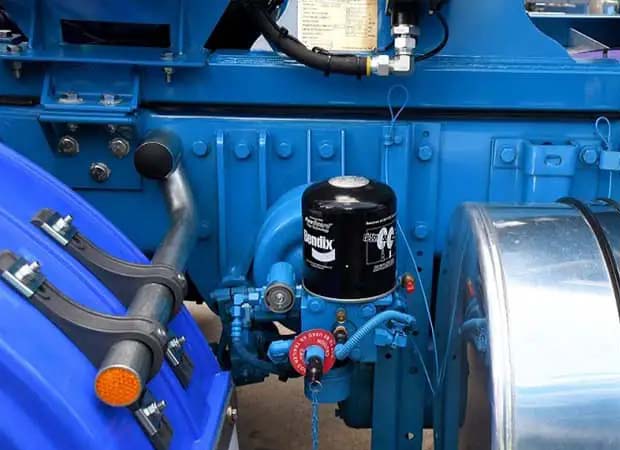Air dryers play a crucial role in maintaining the quality of compressed air in various industrial applications. These devices work by removing moisture and contaminants from the compressed air, ensuring that downstream equipment operates efficiently and reliably.
However, to maintain optimal performance, it’s essential to regularly purge the air dryer to expel accumulated moisture and contaminants. In this comprehensive guide, we’ll delve into the importance of air dryer purging and answer the question: How often should you purge your air dryer?
Understanding Air Dryer Purging
Before we discuss the frequency of air dryer purging, let’s first understand why purging is necessary. Air dryers utilize various methods, such as refrigeration, desiccant, or membrane technologies, to remove moisture from compressed air. During this process, moisture collects within the dryer’s internal components, including filters, desiccant beds, or condensate traps. If left unchecked, this accumulated moisture can lead to operational issues, such as decreased efficiency, corrosion, and damage to downstream equipment.
Purging is the process of removing accumulated moisture and contaminants from the air dryer’s internal components. This typically involves expelling the collected condensate through drain valves or other discharge mechanisms. By regularly purging the air dryer, you can prevent moisture buildup, maintain optimal performance, and prolong the lifespan of the equipment.
Factors Affecting Purging Frequency
The frequency of air dryer purging can vary depending on several factors, including:
- Operating Conditions: The frequency of purging may be influenced by the operating conditions of the compressed air system, such as air flow rate, temperature, and humidity levels. Systems operating in humid environments or experiencing high demand may require more frequent purging to prevent moisture buildup.
- Type of Air Dryer: Different types of air dryers, such as refrigerated dryers, desiccant dryers, or membrane dryers, have varying capacities and capabilities for moisture removal. The recommended purging frequency may differ based on the specific type and model of the air dryer installed in the system.
- System Design: The design and layout of the compressed air system, including the size and configuration of piping, filters, and drains, can impact the efficiency of moisture removal and the need for purging. Systems with inadequate drainage or insufficient filtration may require more frequent purging to maintain optimal performance.
- Quality Requirements: The quality standards and requirements of the compressed air users may also influence the purging frequency. Applications that demand high-quality, moisture-free air, such as pharmaceutical manufacturing or food processing, may necessitate more frequent purging to meet stringent quality standards.

Determining Purging Frequency
While there is no one-size-fits-all answer to how often you should purge your air dryer, there are several guidelines and best practices to consider:
- Manufacturer Recommendations: Consult the manufacturer’s guidelines and operating manual for your specific air dryer model. Manufacturers typically provide recommendations for purging frequency based on the dryer’s design, capacity, and intended application.
- Regular Inspection and Monitoring: Routinely inspect and monitor the performance of your compressed air system to identify signs of moisture buildup or operational issues. Keep an eye out for excessive condensate in drain traps, pressure drops, or fluctuations in dew point levels, as these may indicate the need for more frequent purging.
- Operating Experience: Use your experience and knowledge of the compressed air system’s behavior to determine an appropriate purging schedule. If you notice a decline in performance or increased moisture-related problems, consider adjusting the purging frequency accordingly.
- Consider Environmental Factors: Take into account environmental factors such as seasonal changes, temperature fluctuations, and humidity levels when determining purging frequency. Systems operating in humid climates or experiencing temperature variations may require more frequent purging to maintain optimal performance.
Best Practices for Air Dryer Purging
In addition to determining the appropriate purging frequency, it’s essential to follow best practices to ensure effective moisture removal and system reliability:
- Schedule Regular Maintenance: Implement a routine maintenance schedule to inspect, clean, and service the air dryer and associated components. Replace filters, desiccant beds, and drain valves as needed to maintain peak performance.
- Monitor Performance Metrics: Install monitoring equipment, such as dew point meters or pressure gauges, to track key performance metrics and detect any deviations from normal operating conditions. Use this data to optimize purging schedules and identify potential issues early.
- Optimize Drainage Systems: Ensure that drain traps, condensate drains, and discharge mechanisms are functioning correctly and free from obstructions. Proper drainage is essential for effective moisture removal and preventing condensate buildup within the air dryer.
- Train Personnel: Provide training to operators and maintenance personnel on proper air dryer operation, maintenance procedures, and troubleshooting techniques. Knowledgeable staff can help identify and address issues promptly, minimizing downtime and ensuring system reliability.
Conclusion for How Often Should Air Dryer Purge
In conclusion, air dryer purging is a critical maintenance task that helps maintain the performance and reliability of compressed air systems. While the frequency of purging may vary depending on factors such as operating conditions, system design, and quality requirements, it’s essential to follow manufacturer recommendations, monitor system performance, and implement best practices for effective moisture removal. By prioritizing regular maintenance, monitoring, and training, you can ensure that your air dryer operates efficiently and delivers high-quality, moisture-free compressed air to meet the needs of your application.
